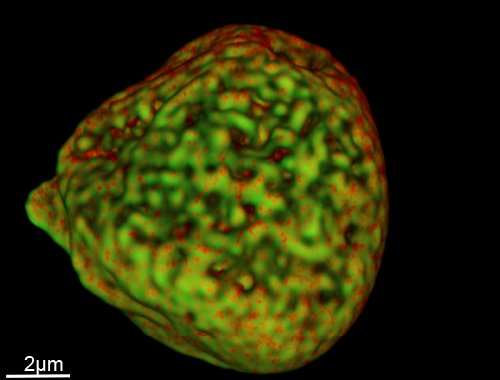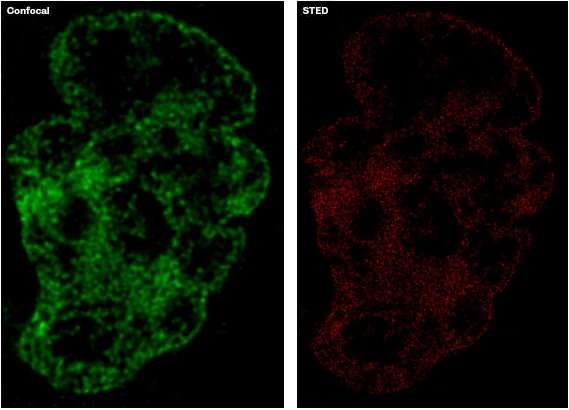New super-resolution probe captures cells in unprecedented detail

Scientists have developed a new technique to capture images of the nucleus of a cell in unprecedented detail, paving the way for new insights into human disease and ageing.
By using a new luminescent probe to light up cell components, researchers in the Department of Chemistry at the University of Sheffield have captured striking 3D images of DNA within nuclei at scales below 40 nanometres (one nanometre = one-billionth of a metre).
The probe's unique properties make it better suited for use in super-resolution microscopy than existing probes, which are not stable enough to suffer long periods of irradiation under intense light that this branch of microscopy requires.
Sree Sreedharan, a PhD student in the Department of Chemistry, developed the probe based on the chemical Ruthenium, in collaboration with the Rutherford Appleton Laboratory in Oxford and researchers in Sheffield's Departments of Biomedical Science, and Physics and Astronomy.
His supervisor, Professor Jim Thomas said: "Since the probe is stable as a rock – even in the most intense laser light – we can take many layers of images to construct final, highly detailed, 3D structures showing DNA laid out out in the nucleus.

"As DNA provides the blueprints for life, super-resolution studies will help to understand how it is stored, read, and processed. Such studies will provide new insights intodevelopment of diseases such as cancer and perhaps even the cellular processes involved in ageing."
By investigating how healthy cells operate and what happens when they malfunction, researchers can reach a deeper understanding of how life works at its most fundamental level, and develop new medicines and treatments for diseases.
However, cells are microscopic, transparent, and most often colourless. To see them through microscopes, scientists use luminescent probes that bind to and "light up" cell components. While this approach has massively advanced our understanding of cell function, any features smaller than around 300 nanometres cannot be distinguished by normal light-based microscopes.
Super-resolution microscopes have been developed in the last decade, which can, in the right circumstances, operate at much smaller scales. Eric Betzig, Stefan W. Hell and William E. Moerner were awarded the Nobel Prize in Chemistry in 2014 for their work in this field.
The challenge for chemists is to develop new probes with optical properties that meet the demands that these advanced techniques place on them – for example, STED (stimulated emission depletion) microscopy needs probes that are exceptionally photochemically stable.
The new Ruthenium-based probe was developed for use in scanning transmission electron microscopy (STEM) and findings have been published online in the Journal of the American Chemical Society. The research was completed as part of the University of Sheffield's Imagine: Imaging Life project, which is using revolutionary microscopy techniques to answer some of the biggest questions in biology and medicine.
More information: Sreejesh Sreedharan et al. Multimodal Super-resolution Optical Microscopy Using a Transition-Metal-Based Probe Provides Unprecedented Capabilities for Imaging Both Nuclear Chromatin and Mitochondria, Journal of the American Chemical Society (2017). DOI: 10.1021/jacs.7b08772
Journal information: Journal of the American Chemical Society
Provided by University of Sheffield



















